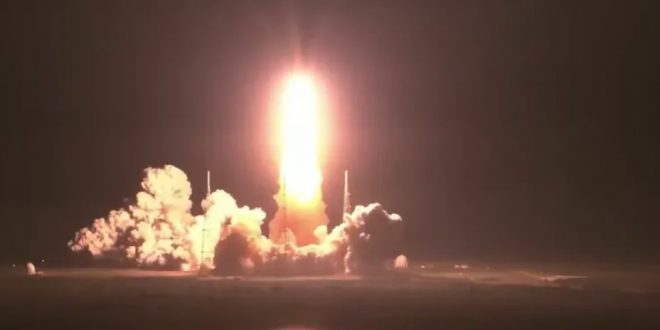The Orion spacecraft was launched using the Space Launch System. The US government’s space program is entering a whole new era.
On Wednesday, NASA launched its enormous next-generation rocket into space for the first time with a roar that illuminated the night sky. A brave new era for the US government’s space program began with the launch of the Space Launch System rocket, or SLS, at 1:47AM ET from Cape Canaveral, Florida.
It also represents a significant accomplishment for NASA’s Artemis program, which has endured years of setbacks, development hiccups, and enormous expense overruns. Hurricanes and technological issues also contributed to launch delays over the preceding few months, including two scrubs. Then, tonight, in the final hours before launch, engineers were able to resolve a sporadic hydrogen leak as well as a “broken ethernet switch.”
Now that most of those issues are behind them, NASA can concentrate on the program’s future.
Charlie Blackwell-Thompson, the Artemis launch director, declared, “For the Artemis generation, this is for you.”
We are going.
For the first time, the @NASA_SLS rocket and @NASA_Orion fly together. #Artemis I begins a new chapter in human lunar exploration. pic.twitter.com/vmC64Qgft9
— NASA (@NASA) November 16, 2022
Prior to the separation of the two vehicles and the core stage of the rocket falling back to Earth and splashing into the Pacific Ocean, the SLS transported its Orion capsule to an altitude of slightly under 4,000 kilometers. (The two solid boosters, which had already split apart, fell back into the Atlantic.) Orion will keep moving until it reaches the Moon, where it will orbit for a few days before heading back to Earth. On December 11, the capsule is expected to splash down in the water. Orion is unmanned for this mission save from three mannequins, two of which have sensors to detect radiation levels.
During the #Artemis I flight test, our @NASA_Orion spacecraft will travel to 40,000 miles beyond the Moon, farther than any crewed missions have flown: https://t.co/CL5LXUjDbZ
— NASA (@NASA) November 16, 2022
Testing Orion’s heat shield, which will have to withstand temperatures of 2,800 degrees Celsius as it enters the Earth’s atmosphere, is one of the key objectives of this voyage. Additionally, NASA will test navigation, communications, sensors, and radiation protection.
Future deep space missions will use NASA’s most potent rocket configuration, which was tested during the SLS flight. With a height of 322 feet and a weight of 5.75 million pounds, Artemis I is the first integrated SLS and Orion flight and is 17 feet taller than the Statue of Liberty. SLS will generate 8.8 million pounds of maximum thrust during launch and ascent, which is 15% greater thrust than the Saturn V rocket.
Although the launch of the rocket was originally scheduled for 2017, it has repeatedly run over budget and behind schedule. Government auditors charged NASA of failing to be open about cost overruns that raised the final budget by almost $1.8 billion.
But this year, it was finally prepared for launch. Engine No. 3 failed to reach the required temperature for the launch on August 29th, which NASA reportedly blamed on a possibly malfunctioning sensor. The first launch attempt was cancelled. A persistent hydrogen leak that developed during fuelling on September 3 and resisted engineers’ numerous attempts to diagnose the problem forced NASA to scrub the launch once more. Hurricanes Ian and Nicole further postponed NASA’s launch timetable until November 16 after the leaks were discovered.
As @NASA_Orion begins the #Artemis I mission to the Moon, the spacecraft captured these stunning views of our home planet. pic.twitter.com/Pzk3PDt7sd
— NASA Artemis (@NASAArtemis) November 16, 2022
Although the weather was kind this time, hydrogen remained a problem. NASA dispatched a team of three technicians, known as a “Red Crew,” to the launch pad itself when a “intermittent” hydrogen leak was discovered. They had to tighten bolts that could repair the faulty valve on the mobile launcher, the sizable platform that supports the enormous rocket, under the shadow of a fully fueled rocket. They had success. The Space Force then discovered that one of their radar systems, which were crucial to the launch, wasn’t operating correctly. It was now necessary to replace an ethernet switch, which took more than an hour. After that was resolved, the mission proceeded without incident.
The Orion spacecraft formally entered trans-lunar orbit over two hours after launch, beginning the next stage of its 26-day trip. The following Artemis mission, scheduled for 2024, will transport an astronaut crew around the Moon and back without making a landing. The first crewed Moon landings since the Apollo 17 mission in 1972 will thereafter be launched by NASA in 2025. The first woman and the first person of color to set foot on the Moon will both do so during this landing.
 Tech Gadget Central Latest Tech News and Reviews
Tech Gadget Central Latest Tech News and Reviews




